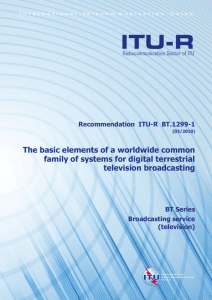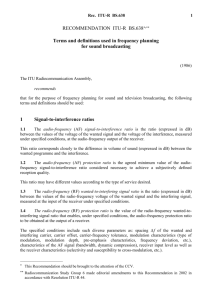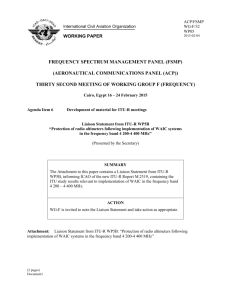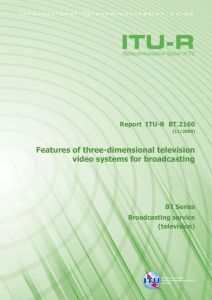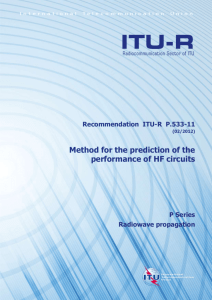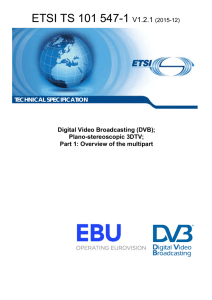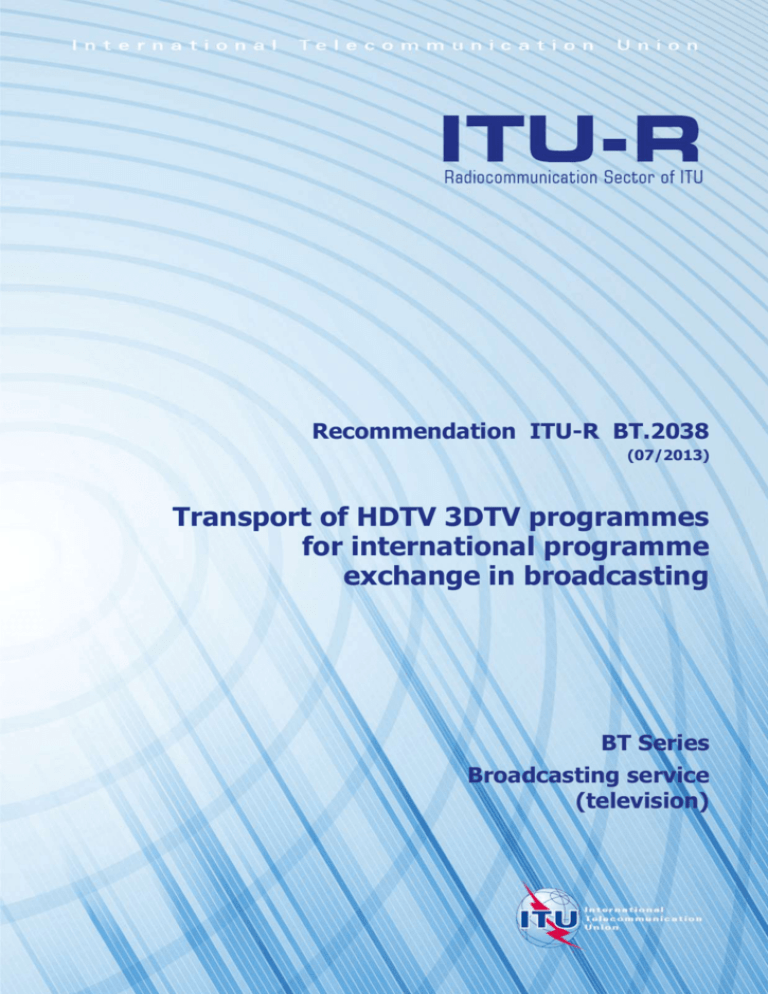
Recommendation ITU-R BT.2038
(07/2013)
Transport of HDTV 3DTV programmes
for international programme
exchange in broadcasting
BT Series
Broadcasting service
(television)
ii
Rec. ITU-R BT.2038
Foreword
The role of the Radiocommunication Sector is to ensure the rational, equitable, efficient and economical use of the
radio-frequency spectrum by all radiocommunication services, including satellite services, and carry out studies without
limit of frequency range on the basis of which Recommendations are adopted.
The regulatory and policy functions of the Radiocommunication Sector are performed by World and Regional
Radiocommunication Conferences and Radiocommunication Assemblies supported by Study Groups.
Policy on Intellectual Property Right (IPR)
ITU-R policy on IPR is described in the Common Patent Policy for ITU-T/ITU-R/ISO/IEC referenced in Annex 1 of
Resolution ITU-R 1. Forms to be used for the submission of patent statements and licensing declarations by patent
holders are available from http://www.itu.int/ITU-R/go/patents/en where the Guidelines for Implementation of the
Common Patent Policy for ITU-T/ITU-R/ISO/IEC and the ITU-R patent information database can also be found.
Series of ITU-R Recommendations
(Also available online at http://www.itu.int/publ/R-REC/en)
Series
BO
BR
BS
BT
F
M
P
RA
RS
S
SA
SF
SM
SNG
TF
V
Title
Satellite delivery
Recording for production, archival and play-out; film for television
Broadcasting service (sound)
Broadcasting service (television)
Fixed service
Mobile, radiodetermination, amateur and related satellite services
Radiowave propagation
Radio astronomy
Remote sensing systems
Fixed-satellite service
Space applications and meteorology
Frequency sharing and coordination between fixed-satellite and fixed service systems
Spectrum management
Satellite news gathering
Time signals and frequency standards emissions
Vocabulary and related subjects
Note: This ITU-R Recommendation was approved in English under the procedure detailed in Resolution ITU-R 1.
Electronic Publication
Geneva, 2013
ITU 2013
All rights reserved. No part of this publication may be reproduced, by any means whatsoever, without written permission of ITU.
Rec. ITU-R BT.2038
1
RECOMMENDATION ITU-R BT.2038
Transport of HDTV 3DTV programmes for international
programme exchange in broadcasting1
(2013)
Scope
This Recommendation specifies the preferred method for transporting HDTV-based 3DTV programmes
using bit rate reduction for various purposes related to international programme exchange.
The ITU Radiocommunication Assembly,
considering
a)
that Recommendation ITU-R BT.2024 specifies the HDTV image systems to be used for
the production and international exchange of 3DTV television programmes for broadcasting; and it
recommends that the Le and Re images2 of a 3DTV image pair should be internationally exchanged
as two full-resolution 1 920 × 1 080 images having the same pixel structure and picture repetition
rate;
b)
that Recommendation ITU-R BT.2027 specifies the HDTV serial digital interface to be
used for the transport of uncompressed HDTV-based 3DTV television programmes in production
and international exchange;
c)
that Recommendation ITU-R BT.1662 provides guidelines on the management of television
image quality post-processing headroom along a generic television chain (from image acquisition to
image presentation);
d)
that Report ITU-R BT.2069-4 indicates the data rate normally required to source-code
monoscopic television programmes for purposes of contribution (which includes international
exchange), primary distribution and SNG network for broadcasting, using the source-coding
method specified in Recommendation ITU-T H.264 (MPEG-4 AVC);
e)
that Recommendation ITU-T H.264 provides specifications for source-coding of 3DTV
signals, offering improved efficiency by exploiting the redundancy between the left-eye (Le) and
the right-eye (Re) signals;
f)
that there will be benefits in terms of programme image quality, if 3DTV television
programme material will be internationally exchanged in transparent source-coded form3 in those
cases whenever the programme material may need to undergo significant 4 image post production at
the receiving end, before it is broadcast;
1
In the context of this Recommendation, the term 3DTV is used to convey a stereoscopic image or image
pair.
2
Le and Re are abbreviations for Left eye, and Right eye, respectively.
3
The ITU-R Terminology database defines “transparent bit-rate reduction” as “a bit-rate reduction process
that does not affect the subjective quality of sound or picture sequences”. In this document, the term
subjective quality includes all the attributes of a stereoscopic image including its ability to reproduce
transparently the depth information of the original scene.
4
“Significant post production” would be described as a signal post processing such as colour correction or
image rescaling or post production through devices using more than one intermediate bit rate reduction
process.
2
Rec. ITU-R BT.2038
g)
that, in those cases when the programme material may require no or only a modest 5 amount
of image post production at the receiving end before it is broadcast, there will be benefits in terms
of the required data rate, if 3DTV television programmes will be internationally exchanged in
source-coded form at the quality level typical of contributions6;
h)
that, in those cases when considerations of data rate override considerations of picture
quality, as it may be the case of an ENG or SNG contribution to a news programme, some
compromises in picture quality may need to be accepted in the international program exchange in
order to reduce the data rate required to deliver such a contribution,
recommends
1
that, when it is necessary to transport HDTV-based 3DTV programme material in a
virtually transparent or quasi-transparent form using a reduced bit rate, the 1 920 × 1 080 signals of
Recommendation ITU-R BT.2024 should be source-coded as specified in Recommendation
ITU-T H.264 (MPEG-4 AVC), at least until more efficient source coding methods will be widely
introduced in broadcasting operations;
2
–
–
–
–
that,
the source-coding method should meet, but preferably exceed, the indications contained in
Report ITU R BT.2069-4 for virtually transparent, or quasi-transparent MPEG-4 AVC
source-coding of monoscopic television programmes (see Notes 1 and 2);
the source-coding separately applied to both Le and Re image signals should not introduce
perceived picture quality difference between the two images;
following source-coding, the Le and Re image signals may be transported in a MultiProgramme Transport Stream (MPTS), or they may be transported in two separate transport
streams;
the relative timing between Le and Re signals should be maintained after encoding,
transporting and decoding;
3
that, in those cases of international programme exchange when it is necessary to use the
lowest possible data rate, as it may be the case of an ENG or SNG for a broadcast news programme:
–
the appropriate source-coding method specified in Recommendation ITU-T H.264
(MPEG-4 AVC) for 3DTV applications should be used, that offers the highest-efficiency
source-coding of the Le and Re image signals, while preserving a picture quality adequate
for programme distribution7 by exploiting the redundancy between the two signals;
–
the relative timing between Le and Re signals should be maintained after encoding,
transporting and decoding;
NOTE 1 – Informative Annex 1 provides a general estimation of the minimum bit rate typically to
be expected from source-coding 3DTV programmes for purposes of international programme
exchange, for the applications described above.
5
“Modest post production” would be described as signal post processing limited to cuts or re-ordering or
processing requiring no further or intermediate bit rate reduction.
6
The ITU-R Terminology database defines “contribution” as “the use of a broadband service or channel for
transferring audio or video information to a user for further post-production processing and subsequent
distribution”.
7
Recommendation ITU-R BT.1687 defines the term “distribution” as “the carriage of television programs
for which no further post-production processing is expected”.
Rec. ITU-R BT.2038
3
NOTE 2 – It is likely that the source-coding method specified in Recommendation ITU-T H.262
(MPEG-2) will not be widely used to source-encode 3DTV programme material for international
programme exchange, for reasons of data-rate economy.
Annex 1
(Informative)
Estimation of the data rate required when source-coding 3DTV television
broadcasting programmes in virtually transparent and quasi-transparent
form for international programme exchange
The table in this informative Annex provides an approximate estimate of the bit rate that would
typically be required when source-coding 3DTV programmes in virtually transparent and quasitransparent form for international exchange, when the left-eye (Le) and the right-eye (Re) images of
the 3DTV programme are separately source-coded.
The table does not take into account the option to exploit the redundancy between the Le and the Re
image signals, since that option should preferably only be used for distribution purposes and for the
transport of ENG/SNG signals.
Bit rate
reduction
Level
Profile
1 920×1 080/60/50/I
H.264/AVC
4
High
4:2:2
35 or greater where no or modest post
production processing is required or
60 or greater where complex post
production processing is required
1 920×1 080/24/25/30/P
H.264/AVC
4
High
35 or greater no or modest post production
processing is required or
60 or greater where complex post
production processing is required
1 920×1 080/60/50/P
H.264/AVC
4.2
High
50 or greater where no or modest post
production processing is required or
90 or greater where complex post
production processing is required or both
3DTV image system
______________
Estimation of required bit rate (Mbit/s)
for each image signal



